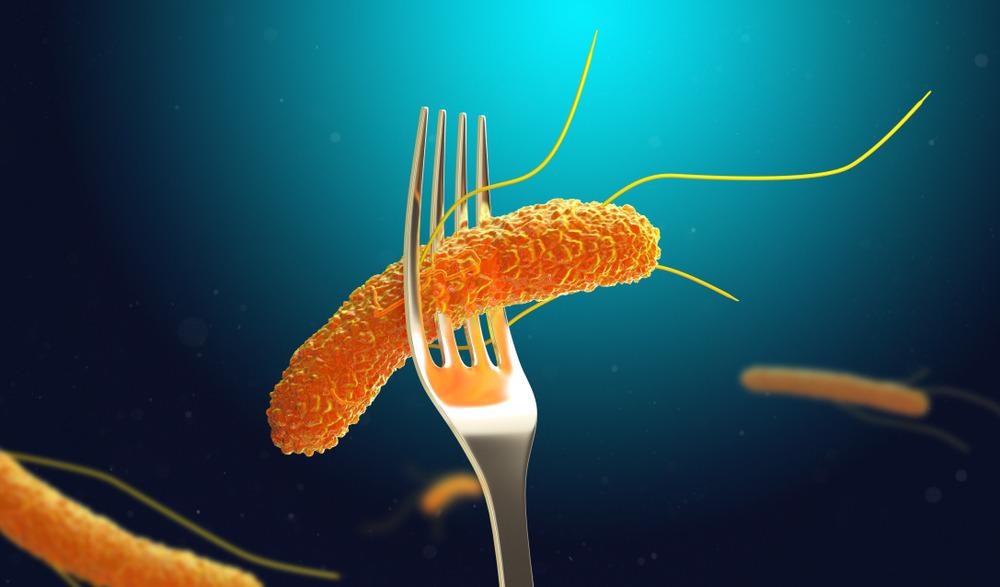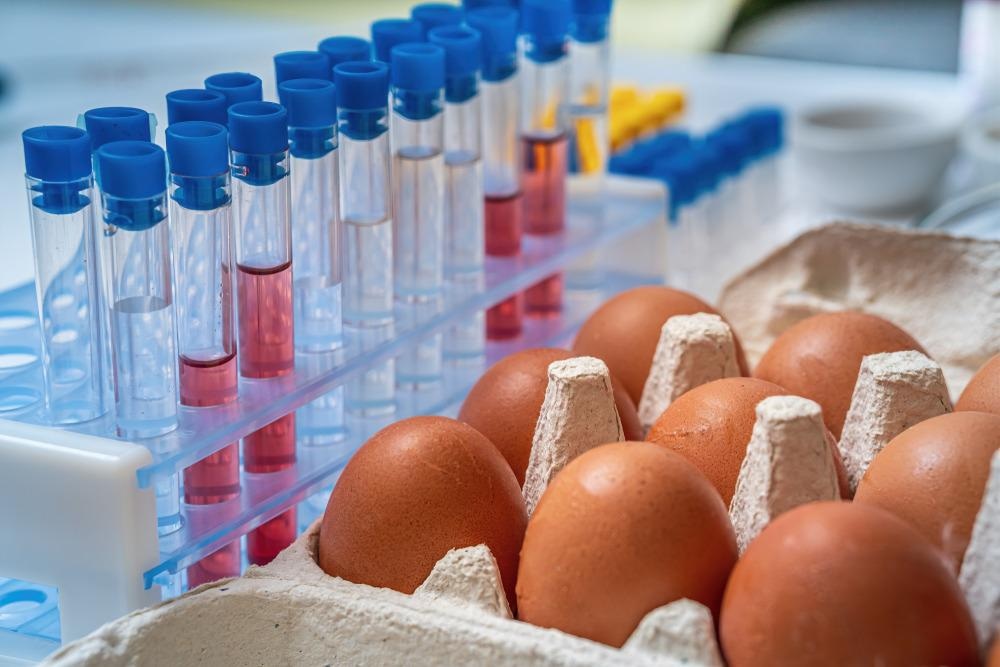Salmonella is a mucosal pathogen that interacts with the host immune system; this interaction makes it an attractive target as an antigen delivery vector. Typically, exposure to wild-type salmonella results in a robust immune response that provokes lifelong immunity.
Consequently, using recombinant Salmonella strains that express heterologous genes, an immune response can be elicited against a pathogen from which the heterologous gene was derived – this makes this bacterium an attractive vector for a vaccine.

Image Credit: Festa/Shutterstock.com
Salmonella alongside other bacteria such as E coli, listeria, shigella, and vibrio, are all potential vectors for oral vaccines. However, salmonella is particularly invasive and this can home the host to immune cells. This results in successful eliciting of B&T cell memory responses which show the greatest potential in provoking long-lasting mucosal (the immune response in the mucous membrane), humoral, and cellular immunity.
Humoral immunity and cell-mediated immunity are two types of adaptive immune responses. Humoral immunity is primarily driven by the B lymphocytes, that develop in the bone marrow and is characterized by macromolecular mediation – namely antibodies, complement protein, and other microbial peptides.
The cellular immune response involves the activation of immune cells, namely phagocytes, antigen sensitized cytotoxic T cells, and is characterized by the release of cytokines and chemokine in response to an antigen. This form of immunity is more effective against viruses, intracellular bacteria protozoans, fungi, and cancerous cells
The Pathogenicity of Salmonella
Pathogenic Salmonella enters the body via the gastrointestinal tract as a consequence of eating contaminated food. The ingested bacteria pass through and survive the stomach, where there is a low pH environment, salmonella reaches the small intestine which is characterized by the presence of antimicrobial peptides such as defensins, a high osmolarity, short-chain fatty acids, and other commensal microbes.
In the ileum, the final and longest segment of the small intestine, the salmonella makes its way through the mucosal layer coating the intestinal epithelium. Here it adheres and invades the enterocytes or follicle-associated epithelium. This is an epithelial layer that overlays a structure called the Peyer’s patch (PP).
The PP house B cell-rich follicles, macrophages, T cells, and dendritic cells. All of these cells form the bulk of the gut-associated lymphoid tissue. The follicle-associated epithelium contains micro fold cells (M cells). M cells can transpose lumenal substances like soluble proteins, viruses, and bacteria. After salmonella has invaded the payer's patch, it comes into contact with dendritic cells and is phagocytized.
The production of IgA is stimulated by dendritic cells containing salmonella to interact directly with B cells. Moreover, T cell priming by salmonella containing dendritic cells begins in the Peyer's patch and continues into are there any logical tissues, which results in the activation of B cells, CD4+, and CD8+ T cells.
This mounts a systemic cell-mediated and humoral immune response. The strong immune response elicited by salmonella results from the cognate toll-like receptors. These interactions result in the secretion of interleukin 8 and pro-inflammatory cytokines IL-1β, IL-6, TNFα, and IFNγ. The proinflammatory cytokine production activates monocytes, neutrophils, and dendritic cells.
Live Attenuated Salmonella Vaccines
Live oral attenuated salmonella vaccines have several advantages over other vaccine types. They can induce local immune responses in the gut as well as stimulate the humoral and cellular immunities. Oral administration routes result in less hazardous waste production during delivery and improve the efficacy of vaccine distribution to large populations.
However, there is a challenge to producing a live vaccine that is both sufficiently attenuated and well tolerated while also able to stimulate protective immune responses. This requires tuning the balance between reactogenicity with immunogenicity.
At present, the only licensed live oral attenuated salmonella vaccine is Ty21a, (produced using chemical mutagenesis). Consequently, it carries several mutations including a deficiency in UDP-galactose-4-epimerase activity. This demonstrates a poor specificity when generating mutants using random mutagenesis. Moreover, Ty21a requires four doses for eliciting an optimal response, alongside a booster every five years.
Newer generation vaccines require the development of candidates that are effective at a single dose, with mutations that can be easily targeted and defined. By using genetic engineering, site-directed mutagenesis can result in better characterization of mutants. Moreover, the induction of multiple mutations will reduce the likelihood of reversion to the wild type in vaccine strains, which will allow them to become pathogenic.
Several S. Typhi vaccine candidates ARE IN Phase 1 clinical trials. For example, M01ZH09, an S. Typhi Ty2 ΔaroC ΔssaV mutant, which has both ssaV deletion in the Type 3 Secretion System (T3SS), has limited intracellular replication as well as the aroC mutation which makes it reliant on aromatic amino acids for growth.
While this vaccine was able to induce antibody responses to lipopolysaccharide and flagellin, a single dose was not sufficient to protect against the development of typhoid fever when challenged with the variance drain of Salmonella Typhi.
The Center for Vaccine Development and Global Health has also produced several other candidates; among them, the candidate CVD 909 is the most promising, and able to elicit specific immune responses in addition to anti-lipopolysaccharide and anti-flagellin responses come out which makes this an ideal typhoid vaccine candidate.
While many vaccine candidates have been developed, very few have been assessed in clinical trials. These facultative intracellular pathogens can use several systems to transport effective proteins into host cells. Therefore they serve as ideal vectors to deliver foreign antigens to create live carrier vaccines for simultaneous immunization against several pathogens. In addition, salmonella can be genetically modified with ease, due to a large body of knowledge about its pathogenicity. It, therefore, serves as a model organism to test these new approaches.
Despite this, among the live attenuated Salmonella vaccines that have been developed, they are highly immunogenic and easy to administer and more research is needed to reduce fecal shedding.

Image Credit: vchal/Shutterstock.com
References:
- Roland KL, Brenneman KE. (2014) Salmonella as a vaccine delivery vehicle [published correction appears in Expert Rev Vaccines. Expert Rev Vaccines. doi:10.1586/14760584.2013.825454.
- Sears KT, Galen JE, Tennant SM. (2021) Advances in the development of Salmonella-based vaccine strategies for protection against Salmonellosis in humans. J Appl Microbiol. doi: 10.1111/jam.15055.
Further Reading